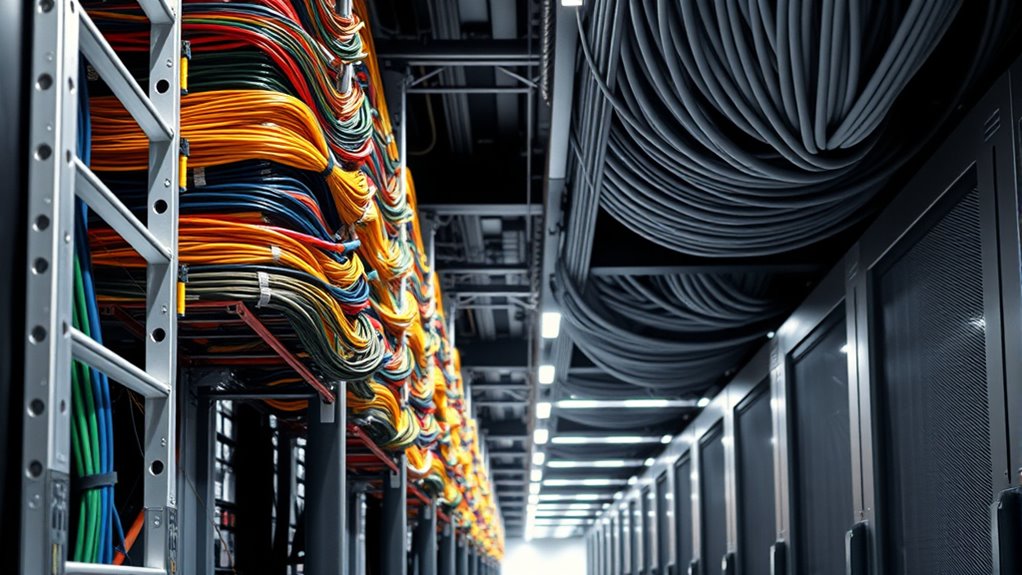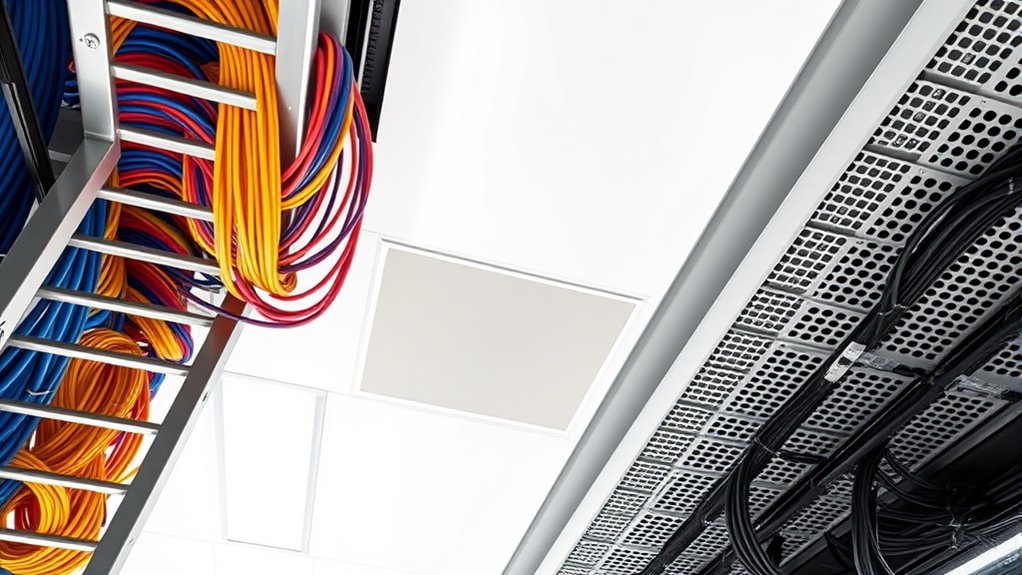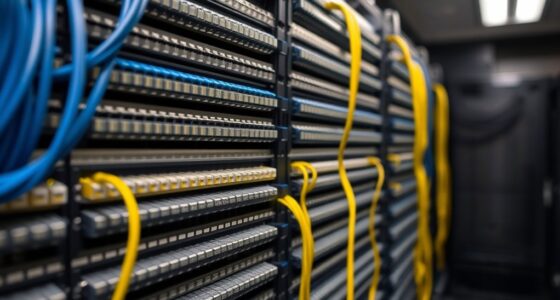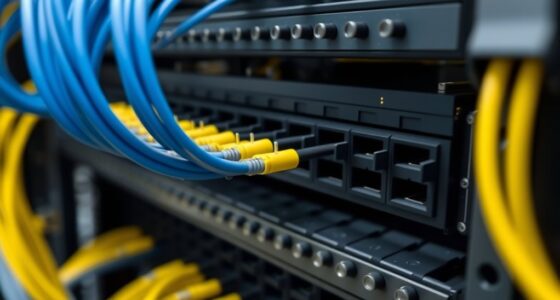When choosing between cable ladder racks and cable trays for your data center, consider that ladder racks support heavy cables and provide excellent airflow, making maintenance easier. Cable trays, on the other hand, offer a neater look and protect cables from dust and debris, with simpler installation. Your decision depends on your needs for capacity, cooling, and accessibility. Keep exploring to discover how each option can best fit your specific environment and requirements.
Key Takeaways
- Ladder racks support heavy cables with open design for superior airflow and easy access, ideal for high-capacity data centers.
- Cable trays provide enclosed, protective support with a neater appearance, suitable for environments requiring dust and debris protection.
- Ladder racks are installed by mounting to ceilings or walls, offering excellent cable management and cooling, while trays are suspended or attached with clamps.
- Choice depends on capacity needs, airflow requirements, environmental protection, and ease of maintenance in the data center.
- Both systems enhance organization and security but differ in installation complexity, environmental suitability, and cable support style.

When deciding between a cable ladder rack and a cable tray, understanding their differences is essential for choosing the right solution for your electrical wiring needs. Both are types of wire support systems designed to organize and protect cables, but they serve different functions and are installed differently. Your choice depends on factors like cable capacity, accessibility, and the environment of your data center.
Choosing between cable ladder racks and cable trays depends on capacity, accessibility, and environmental needs.
Cable ladder racks are open, ladder-like structures that provide high capacity and excellent airflow. They’re ideal when you need to support large bundles of cables or heavy equipment. The open design allows for straightforward cable management, making it easier to add, remove, or reroute cables as your system evolves. When considering installation methods for ladder racks, you’ll find that they typically require mounting to ceilings or walls using brackets or supports. These systems are often anchored to structural elements, providing a sturdy framework capable of supporting significant weight. Because they’re open, ladder racks also facilitate cooling, which is *imperative* in data centers where heat dissipation impacts equipment performance.
Cable trays, on the other hand, come in various types such as solid-bottom, ventilated, or wire mesh, offering more enclosed support for cables. They’re suitable when you need a neater appearance or when environmental factors demand a degree of protection from dust or debris. The installation methods for cable trays usually involve suspending them from ceilings or attaching them to walls, using clamps, brackets, or hangers. They typically require less structural modification than ladder racks and can be quickly installed in existing infrastructure. Cable trays also make cable management easier in tight spaces, as they can be customized in length and shape to fit specific layouts. Their design helps prevent accidental disconnections and offers a degree of physical protection for the cables.
Ultimately, your decision hinges on your specific needs. If you require high capacity, excellent airflow, and easier access for maintenance or upgrades, a cable ladder rack is likely the better choice. Conversely, if a cleaner look, environmental protection, or quick installation is more important, a cable tray might be preferable. Both systems are versatile and adaptable, but understanding their installation methods and how they support your wire support systems is *crucial*. Proper selection ensures your cables stay organized, secure, and efficient, reducing downtime and maintaining *ideal* data center performance. Taking the time to evaluate your wiring requirements now will save you effort and costs down the line, ensuring your data center remains reliable and well-organized.
Frequently Asked Questions
How Do Installation Costs Compare Between Cable Ladder Racks and Cable Trays?
You’ll find that cable trays generally have lower installation costs due to their simplicity and ease of setup, making them more cost-efficient for many projects. Cable ladder racks, while more durable and suited for heavier loads, tend to involve higher installation complexity and labor costs. If cost efficiency is your priority, cable trays often save you money upfront and during installation.
Which Solution Offers Better Scalability for Future Data Center Expansion?
You’ll find cable ladder racks offer better scalability due to their modular design, making future proofing easier. They allow you to expand and reconfigure easily as your data center grows, accommodating increasing cable loads without much hassle. Cable trays, while simpler, often lack this flexibility, which can limit your expansion options. So, if future growth matters, cable ladder racks are the smarter choice for seamless scalability.
Are There Specific Industry Standards Governing Cable Ladder Rack and Tray Use?
Yes, there are specific industry standards and regulatory compliance requirements that govern cable ladder rack and tray use. You should adhere to standards like ANSI/TIA-568 and IEC for safety, performance, and installation practices. Following these guidelines guarantees your data center remains compliant, minimizes risks, and maintains excellent organization. By prioritizing industry standards, you guarantee your cable management system is reliable, safe, and scalable for future growth.
How Do Maintenance Requirements Differ Between the Two Systems?
You’ll find maintenance requirements differ between cable ladder racks and cable trays. Ladder racks often need less frequent maintenance but require thorough inspection procedures to check for loose connections or corrosion. Trays, on the other hand, might need more regular inspections to ensure cables remain organized and secure, especially in high-traffic data centers. Regular maintenance frequency and detailed inspection procedures help prevent issues and guarantee system longevity.
What Are the Environmental Impacts of Using Cable Ladder Racks Versus Cable Trays?
You’ll find that cable ladder racks often have a larger environmental footprint due to their heavier materials, which can lead to higher energy use during manufacturing and installation. However, they tend to use recyclable materials, making reuse easier. Cable trays typically have a smaller environmental impact because they’re lighter and often made from recyclable metals. Choosing the right system depends on balancing your data center’s environmental goals and material sustainability.
Conclusion
So, which option will you choose for your data center? Will the rugged durability of a cable ladder rack or the versatile convenience of a cable tray suit your needs better? The decision isn’t simple, and the right choice could transform your setup in unexpected ways. Imagine the impact of your decision—are you ready to make it? The best solution is waiting just around the corner. The choice is yours—are you prepared to take it?









